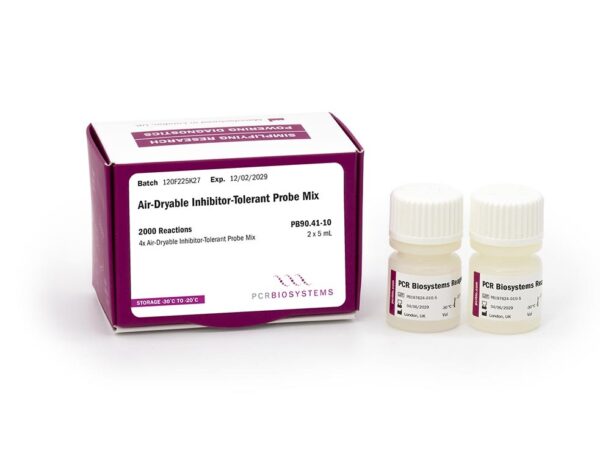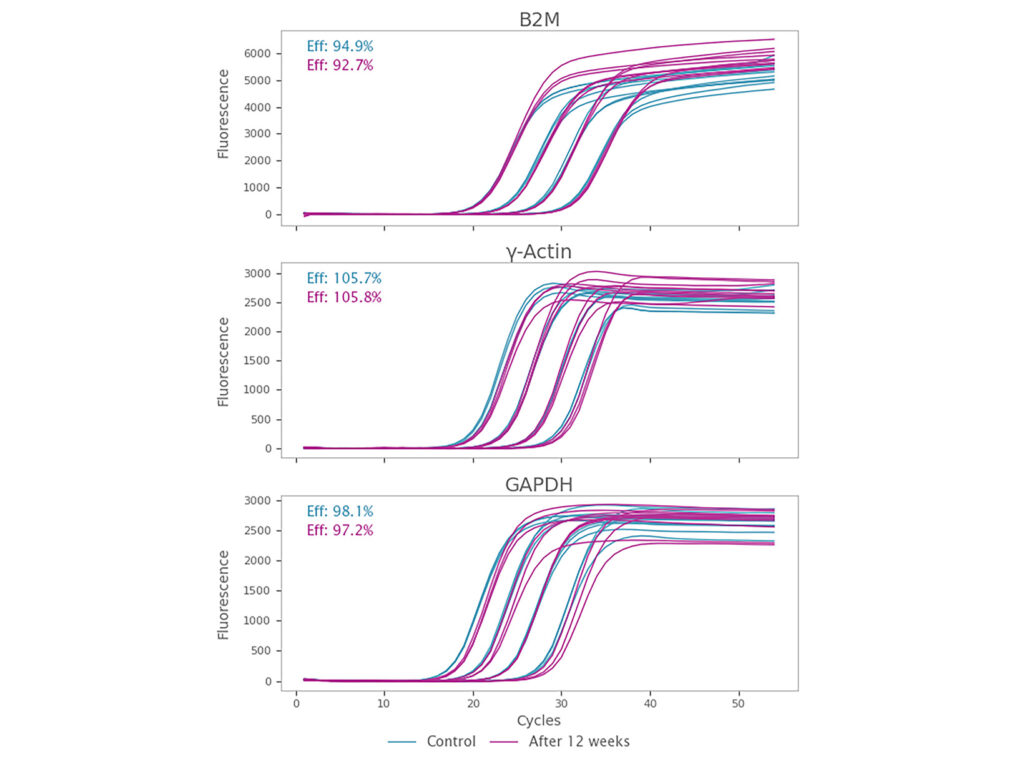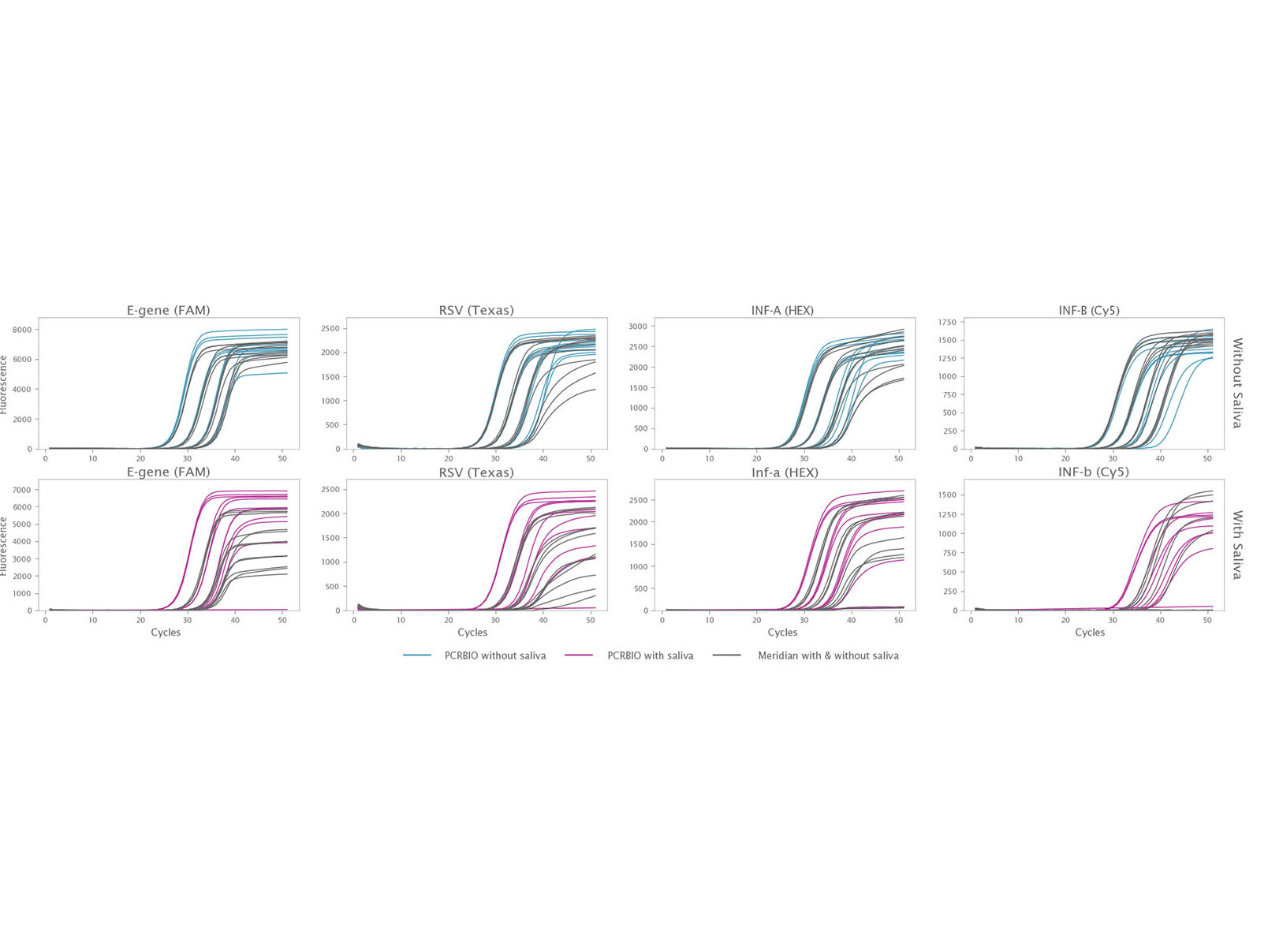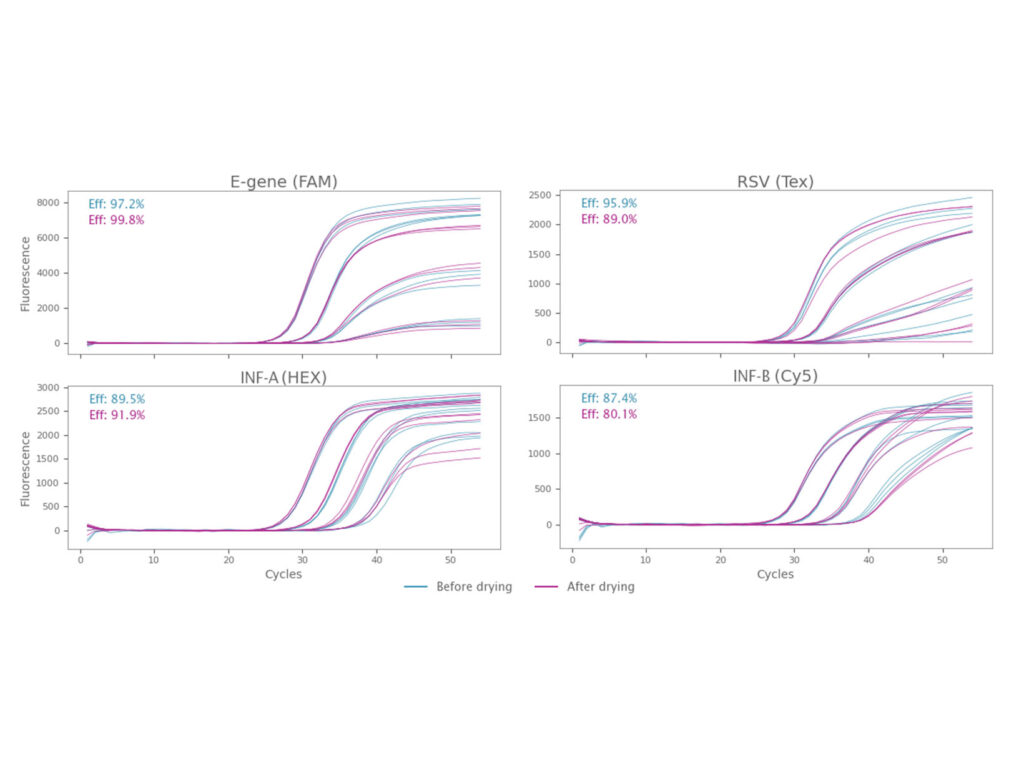Air-Dryable Inhibitor-Tolerant qPCR Probe Mixes

Air-Dryable Inhibitor-Tolerant Probe Mix and Probe 1-Step Mix are easily dryable broad-spectrum inhibitor-tolerant 4x mixes for probe-based qPCR and 1-step RT-qPCR.
Achieve consistent, reliable results with our Air-Dryable Inhibitor-Tolerant Probe Mixes. Perfectly designed for analysis of challenging samples, including saliva, clinical and environmental samples, and laboratory chemicals. Featuring compatibility with all real time instruments, these dryable reagents enable qPCRs for both DNA and RNA detection. Air-Dryable Inhibitor-Tolerant qPCR mixes combine our novel inhibitor-tolerant chemistry with our cutting-edge air-dryable technology.
Air-Dryable Inhibitor-Tolerant Probe Mixes have been extensively tested against:
- Crude saliva (10%)
- Crude blood (6%)
- Laboratory chemicals (SDS, guanidine, ethanol)
- Clinical inhibitors (hemin, hemoglobin, heparin, lactoferrin, immunoglobulins, urea)
- Plant, and environmental inhibitors (humic acid, catechin, quercetin, tannic acid, cellulose, and chlorophyll).
Features
- Standard and ultra-fast cycling (down to 3 min RT reaction and 1 s denaturation, 3 s annealing/extension for PCR)
- Broad-spectrum inhibitor tolerance
- Unbiased, sensitive detection of both DNA and RNA targets
- Complete 1-step RT-qPCR mix, single tube format
- Easy reaction setup, add only primers & probes before drying
- Rapid air-drying protocol, 80-90 min drying time
- Same high performance before & after drying
- Stable at room temperature for at least 12 months after drying
- Room temperature storage and shipping of dried reactions


What are Air-Dryable Inhibitor-Tolerant Probe Mixes?
PCRs and qPCR can be inhibited by a wide variety of chemical compounds. Such inhibitors can negatively affect qPCR workflows and diagnostic processes. Air-Dryable Inhibitor-Tolerant Probe Mixes are 4x ready-mixes that include a hot start Taq DNA polymerase (and RTase and RNase inhibitor, in the case of the 1-step mix), buffering agents, magnesium, dNTPs, and a blend of excipients to ensure reliable air-drying, without loss of activity, thus, ensuring successful probe-based qPCR, in a single-tube format. The end-user can combine these mixes with primers, probes, and template for single- or multiplex detection. These mixes are universally compatible with all probe chemistries, including TaqMan, Scorpions and molecular beacons, as well as being maximally compatible with all commercial real time PCR instruments.
Additionally, both mixes are air-dryable (glycerol-free), and as such can be dried down in a standard laboratory oven for long term storage at ambient temperature without any loss of activity. Designed for rapid air-drying, Air-Dryable Inhibitor-Tolerant Probe (1-Step) Mixes are intended for use in in vitro diagnostic kit development (IVD) but can also be used for anyone wishing to benefit from the advantages of dried (RT-)qPCR reactions. Air-drying protocols require significantly less time and expertise than freeze drying (lyophilisation) and very simple equipment. 5 μL of 4x Air-Dryable Inhibitor-Tolerant Probe (1-Step) Mixes (required for a 20 μL final reaction volume) can be dried down into a gel using a standard laboratory oven in as little as 80-90 min.

What type of templates are these mixes suitable for?
The probe mix is suitable for amplification of DNA templates. The 1-step mix can be used to amplify both DNA and RNA samples without a loss in efficiency, regardless of template type.
Types of inhibitors Air-Dryable Inhibitor-Tolerant Probe Mixes tolerate.
Both probe and probe 1-step qPCR mixes have been tested against, and are tolerant to, a broad range of common PCR inhibitors, including, but not limited to, standard laboratory chemicals (SDS, guanidine, and ethanol) and biological sample inhibitors, such as those found in blood samples (hemin, hematin, haemoglobin, heparin, IgG immunoglobulins, lactoferrin, sodium citrate), saliva, urine (urea), plant, and environmental samples (humic acid, catechin, quercetin, tannic acid, cellulose, and chlorophyl). The mixes have been extensively validated against crude (or diluted) saliva and blood, along with multiple other pure chemical inhibitors.
Key benefits of air-drying
- Reduced volume and mass of reaction mixes leads to cheaper shipping and storage.
- Room temperature stability of the air-dried final gel eliminates the need for cold-chain shipping and storage. This simplifies logistics and reduces overall cost.
- Increased volumes of sample can be used. The sample input volume can equal the final reaction volume. This is perfect for dilute samples with a low target copy number.
- Air-drying in an oven is a highly accessible method, because there is no requirement for specialist equipment and knowledge, eliminating the need for additional staff or project out-sourcing
- Increased control over the drying process and final product development for small and medium sized IVD kit developers
Applications
- Diagnostic probe-based qPCR & RT-qPCR
- DNA & RNA detection
- TaqMan, Scorpions and molecular beacon probe qPCR
- Multiplex and singleplex setup
- Crude saliva qPCR & RT-qPCR
Documents
Product Flyers
Product Manuals
Material Safety Data Sheets
Application Notes
- Application Note: Robust Clara® & Air-Dryable Inhibitor-Tolerant Probe Mixes tolerate a wide range of inhibitors
- Inhibitor-Tolerant Probe Mixes enable reliable target detection in crude saliva samples
- Developing Air-Dried, Inhibitor-Tolerant qPCR Assays: A simple fast and low-cost option for point-of-care diagnostics
Certificate of Analysis Finder
Specifications
Air-Dryable Inhibitor-Tolerant Probe Mix
Component
600 Reactions
2000 Reactions
10 000 Reactions
4x Air-Dryable Inhibitor-Tolerant Probe Mix
3 x 1 mL
2 x 5 mL
1 x 50 mL
Air-Dryable Inhibitor-Tolerant Probe 1-Step Mix
Component
600 Reactions
2000 Reactions
10 000 Reactions
4x Air-Dryable Inhibitor-Tolerant Probe 1-Step Mix
3 x 1 mL
2 x 5 mL
1 x 50 mL
Air-Dryable Inhibitor-Tolerant Probe Mix
Component
4x Air-Dryable Inhibitor-Tolerant Probe Mix
600 Reactions
3 x 1 mL
2000 Reactions
2 x 5 mL
10 000 Reactions
1 x 50 mL
Air-Dryable Inhibitor-Tolerant Probe 1-Step Mix
Component
4x Air-Dryable Inhibitor-Tolerant Probe 1-Step Mix
600 Reactions
3 x 1 mL
2000 Reactions
2 x 5 mL
10 000 Reactions
1 x 50 mL
Reaction Volume
Storage
20 μL
On arrival, products should be stored between -30 °C and -20 °C. If stored correctly the kit will retain full activity until the indicated expiry date.
Reaction Volume
20 μL
Storage
On arrival, products should be stored between -30 °C and -20 °C. If stored correctly the kit will retain full activity until the indicated expiry date.
Instrument Compatibility
This product is compatible with all standard and fast cycling qPCR instruments that do not require passive reference dye. If passive reference is required, please contact our team for custom solutions.
FAQs
Can I conduct fast cycling with this mix?
Reliable amplification for various targets has been achieved using 40 cycles with 1 s denaturation and 3 s annealing and extension (2-step cycling). Successful amplification under these conditions requires reasonably short amplicons and should be tested on case-by-case basis for all new targets added to an experiment.
Can I use crude plant extracts with this mix?
Results will differ depending on the plant species and tissue type. Our inhibitor-tolerant chemistry shows moderate resistance to chlorophyll and polyphenols, such as catechin and quercetin, but low resistance to tannic acid, cellulose and pectin. Thus, testing the mix on the desired sample types is recommend. All plant tissues will require mechanical lysis in an appropriate extraction buffer to achieve disruption of cell walls and membranes, prior to use with inhibitor-tolerant mixes. We recommend testing a small number of reactions on the target sample type. Please reach out to our team [email protected] to request a product sample, or if you need assistance in planning such test reactions.
Is it normal to see different levels of inhibition with different crude samples?
Yes, this is expected. Crude biological samples, particularly saliva, contain different levels of PCR inhibitors. We have observed a range of 0.5-3.5 cycles delay in amplification of the same target with different saliva samples. The same crude biological sample may also show different levels of inhibition over time.
Is it normal to see some delay in Cq in the presence of crude samples?
Yes. While the mix is inhibitor-tolerant, it is not completely resistant to the presence of inhibitors. Different inhibitors and higher concentrations can still inhibit qPCR reactions. Given the sensitivity of the mix, if a significant delay is observed, we recommend diluting the sample before using in qPCR reactions.
Do I need to pre-treat saliva samples before using them with this mix?
Saliva samples do not require pre-treatment. However, dilution in appropriate sample transport medium is recommended. We highly recommend the use of UTM which don’t contain guanidinum chloride.
How much crude saliva can I add per reaction?
We have successfully tested up to 10% crude saliva per reaction, with best, most-consistent results when using 2.5% saliva
How much crude blood can I add per reaction?
We have successfully carried out multiplex reactions on up to 5 μL of blood sample (1.25 μL of crude blood diluted 1:4 in a NaCl/EDTA solution) per 20 μL reaction. This does lead to a reduction in overall fluorescence but does not inhibit qPCR reactions themselves, nor does it limit the sensitivity of the mix.
What inhibitors does this mix tolerate?
All our inhibitor-tolerant mixes have been tested on and tolerate crude saliva and crude blood. Additionally, they have been extensively tested in the presence of multiple PCR inhibitors found in clinical, plant, environmental, and laboratory chemicals . These include: hemin, haemoglobin, heparin, lactoferrin, IgG immunoglobulins, guanidine, SDS, ethanol, urea, sodium citrate, humic acid, cellulose, pectin, quercetin, catechin, tannic acid, and chlorophyll B. The extent of tolerance varies by compound. The mixes may also be tolerant to other compounds, not listed, or not yet tested.
Can I alter the drying conditions?
The drying conditions provided in the product manual are only an example of the tested cycles used in our labs. When air-drying, it is important to get a loss of weight (Loss on Drying, LoD), of approximately 70-75 %, which results in a dried gel containing only 5-10 % water.
Drying times may vary depending on the instrument used. When using this product for the first time with a specific oven, we recommend measuring the LoD using multiple tubes at regular times (e.g., after 60, 70, 80, 90 min) to define the best protocol and achieve a LoD of 74.5 ± 10.5 % or 70 ± 1 % based on the mix (with or without oligos) and the drying instrument used.
Temperatures can also be changed, but obviously lower temperatures will require longer times, while higher temperatures risk affecting the integrity of the mix components, so we recommend using 40 °C to minimise the chances of unexpected problems.
What should I do if I want to dry down larger volumes?
We do not recommend drying more than 5 – 6 μL of mix (plus oligos) per well following the instructions provided into the manual. Multiple plates can be dried at the same time for high throughput of manufacturing. We do not recommend air-drying larger volumes and recommend lyophilisation, using our Lyo-Ready range of products.
Can I lyophilise this mix?
Although we successfully managed to lyophilise this mix, we do not recommend it be lyophilised. The excipient content has been optimised for air drying and this significantly reduces stability of the product lyophilisation. We recommend using this mix for air-drying only and recommend our Lyo-Ready product range for lyophilisation protocols.
Air-Dryable Inhibitor-Tolerant Probe Mixes have been extensively tested against:
- Crude saliva (10%)
- Crude blood (6%)
- Laboratory chemicals (SDS, guanidine, ethanol)
- Clinical inhibitors (hemin, hemoglobin, heparin, lactoferrin, immunoglobulins, urea)
- Plant, and environmental inhibitors (humic acid, catechin, quercetin, tannic acid, cellulose, and chlorophyll).
Features
- Standard and ultra-fast cycling (down to 3 min RT reaction and 1 s denaturation, 3 s annealing/extension for PCR)
- Broad-spectrum inhibitor tolerance
- Unbiased, sensitive detection of both DNA and RNA targets
- Complete 1-step RT-qPCR mix, single tube format
- Easy reaction setup, add only primers & probes before drying
- Rapid air-drying protocol, 80-90 min drying time
- Same high performance before & after drying
- Stable at room temperature for at least 12 months after drying
- Room temperature storage and shipping of dried reactions


What are Air-Dryable Inhibitor-Tolerant Probe Mixes?
PCRs and qPCR can be inhibited by a wide variety of chemical compounds. Such inhibitors can negatively affect qPCR workflows and diagnostic processes. Air-Dryable Inhibitor-Tolerant Probe Mixes are 4x ready-mixes that include a hot start Taq DNA polymerase (and RTase and RNase inhibitor, in the case of the 1-step mix), buffering agents, magnesium, dNTPs, and a blend of excipients to ensure reliable air-drying, without loss of activity, thus, ensuring successful probe-based qPCR, in a single-tube format. The end-user can combine these mixes with primers, probes, and template for single- or multiplex detection. These mixes are universally compatible with all probe chemistries, including TaqMan, Scorpions and molecular beacons, as well as being maximally compatible with all commercial real time PCR instruments.
Additionally, both mixes are air-dryable (glycerol-free), and as such can be dried down in a standard laboratory oven for long term storage at ambient temperature without any loss of activity. Designed for rapid air-drying, Air-Dryable Inhibitor-Tolerant Probe (1-Step) Mixes are intended for use in in vitro diagnostic kit development (IVD) but can also be used for anyone wishing to benefit from the advantages of dried (RT-)qPCR reactions. Air-drying protocols require significantly less time and expertise than freeze drying (lyophilisation) and very simple equipment. 5 μL of 4x Air-Dryable Inhibitor-Tolerant Probe (1-Step) Mixes (required for a 20 μL final reaction volume) can be dried down into a gel using a standard laboratory oven in as little as 80-90 min.

What type of templates are these mixes suitable for?
The probe mix is suitable for amplification of DNA templates. The 1-step mix can be used to amplify both DNA and RNA samples without a loss in efficiency, regardless of template type.
Types of inhibitors Air-Dryable Inhibitor-Tolerant Probe Mixes tolerate.
Both probe and probe 1-step qPCR mixes have been tested against, and are tolerant to, a broad range of common PCR inhibitors, including, but not limited to, standard laboratory chemicals (SDS, guanidine, and ethanol) and biological sample inhibitors, such as those found in blood samples (hemin, hematin, haemoglobin, heparin, IgG immunoglobulins, lactoferrin, sodium citrate), saliva, urine (urea), plant, and environmental samples (humic acid, catechin, quercetin, tannic acid, cellulose, and chlorophyl). The mixes have been extensively validated against crude (or diluted) saliva and blood, along with multiple other pure chemical inhibitors.
Key benefits of air-drying
- Reduced volume and mass of reaction mixes leads to cheaper shipping and storage.
- Room temperature stability of the air-dried final gel eliminates the need for cold-chain shipping and storage. This simplifies logistics and reduces overall cost.
- Increased volumes of sample can be used. The sample input volume can equal the final reaction volume. This is perfect for dilute samples with a low target copy number.
- Air-drying in an oven is a highly accessible method, because there is no requirement for specialist equipment and knowledge, eliminating the need for additional staff or project out-sourcing
- Increased control over the drying process and final product development for small and medium sized IVD kit developers
Applications
- Diagnostic probe-based qPCR & RT-qPCR
- DNA & RNA detection
- TaqMan, Scorpions and molecular beacon probe qPCR
- Multiplex and singleplex setup
- Crude saliva qPCR & RT-qPCR
Request a Quote & Sample
Your Selection:
Documents
Product Flyers
Product Manuals
Material Safety Data Sheets
Application Notes
- Application Note: Robust Clara® & Air-Dryable Inhibitor-Tolerant Probe Mixes tolerate a wide range of inhibitors
- Inhibitor-Tolerant Probe Mixes enable reliable target detection in crude saliva samples
- Developing Air-Dried, Inhibitor-Tolerant qPCR Assays: A simple fast and low-cost option for point-of-care diagnostics
Certificate of Analysis Finder
Specifications
Air-Dryable Inhibitor-Tolerant Probe Mix
Component
600 Reactions
2000 Reactions
10 000 Reactions
4x Air-Dryable Inhibitor-Tolerant Probe Mix
3 x 1 mL
2 x 5 mL
1 x 50 mL
Air-Dryable Inhibitor-Tolerant Probe 1-Step Mix
Component
600 Reactions
2000 Reactions
10 000 Reactions
4x Air-Dryable Inhibitor-Tolerant Probe 1-Step Mix
3 x 1 mL
2 x 5 mL
1 x 50 mL
Air-Dryable Inhibitor-Tolerant Probe Mix
Component
4x Air-Dryable Inhibitor-Tolerant Probe Mix
600 Reactions
3 x 1 mL
2000 Reactions
2 x 5 mL
10 000 Reactions
1 x 50 mL
Air-Dryable Inhibitor-Tolerant Probe 1-Step Mix
Component
4x Air-Dryable Inhibitor-Tolerant Probe 1-Step Mix
600 Reactions
3 x 1 mL
2000 Reactions
2 x 5 mL
10 000 Reactions
1 x 50 mL
Reaction Volume
Storage
20 μL
On arrival, products should be stored between -30 °C and -20 °C. If stored correctly the kit will retain full activity until the indicated expiry date.
Reaction Volume
20 μL
Storage
On arrival, products should be stored between -30 °C and -20 °C. If stored correctly the kit will retain full activity until the indicated expiry date.
Instrument Compatibility
This product is compatible with all standard and fast cycling qPCR instruments that do not require passive reference dye. If passive reference is required, please contact our team for custom solutions.
FAQs
Can I conduct fast cycling with this mix?
Reliable amplification for various targets has been achieved using 40 cycles with 1 s denaturation and 3 s annealing and extension (2-step cycling). Successful amplification under these conditions requires reasonably short amplicons and should be tested on case-by-case basis for all new targets added to an experiment.
Can I use crude plant extracts with this mix?
Results will differ depending on the plant species and tissue type. Our inhibitor-tolerant chemistry shows moderate resistance to chlorophyll and polyphenols, such as catechin and quercetin, but low resistance to tannic acid, cellulose and pectin. Thus, testing the mix on the desired sample types is recommend. All plant tissues will require mechanical lysis in an appropriate extraction buffer to achieve disruption of cell walls and membranes, prior to use with inhibitor-tolerant mixes. We recommend testing a small number of reactions on the target sample type. Please reach out to our team [email protected] to request a product sample, or if you need assistance in planning such test reactions.
Is it normal to see different levels of inhibition with different crude samples?
Yes, this is expected. Crude biological samples, particularly saliva, contain different levels of PCR inhibitors. We have observed a range of 0.5-3.5 cycles delay in amplification of the same target with different saliva samples. The same crude biological sample may also show different levels of inhibition over time.
Is it normal to see some delay in Cq in the presence of crude samples?
Yes. While the mix is inhibitor-tolerant, it is not completely resistant to the presence of inhibitors. Different inhibitors and higher concentrations can still inhibit qPCR reactions. Given the sensitivity of the mix, if a significant delay is observed, we recommend diluting the sample before using in qPCR reactions.
Do I need to pre-treat saliva samples before using them with this mix?
Saliva samples do not require pre-treatment. However, dilution in appropriate sample transport medium is recommended. We highly recommend the use of UTM which don’t contain guanidinum chloride.
How much crude saliva can I add per reaction?
We have successfully tested up to 10% crude saliva per reaction, with best, most-consistent results when using 2.5% saliva
How much crude blood can I add per reaction?
We have successfully carried out multiplex reactions on up to 5 μL of blood sample (1.25 μL of crude blood diluted 1:4 in a NaCl/EDTA solution) per 20 μL reaction. This does lead to a reduction in overall fluorescence but does not inhibit qPCR reactions themselves, nor does it limit the sensitivity of the mix.
What inhibitors does this mix tolerate?
All our inhibitor-tolerant mixes have been tested on and tolerate crude saliva and crude blood. Additionally, they have been extensively tested in the presence of multiple PCR inhibitors found in clinical, plant, environmental, and laboratory chemicals . These include: hemin, haemoglobin, heparin, lactoferrin, IgG immunoglobulins, guanidine, SDS, ethanol, urea, sodium citrate, humic acid, cellulose, pectin, quercetin, catechin, tannic acid, and chlorophyll B. The extent of tolerance varies by compound. The mixes may also be tolerant to other compounds, not listed, or not yet tested.
Can I alter the drying conditions?
The drying conditions provided in the product manual are only an example of the tested cycles used in our labs. When air-drying, it is important to get a loss of weight (Loss on Drying, LoD), of approximately 70-75 %, which results in a dried gel containing only 5-10 % water.
Drying times may vary depending on the instrument used. When using this product for the first time with a specific oven, we recommend measuring the LoD using multiple tubes at regular times (e.g., after 60, 70, 80, 90 min) to define the best protocol and achieve a LoD of 74.5 ± 10.5 % or 70 ± 1 % based on the mix (with or without oligos) and the drying instrument used.
Temperatures can also be changed, but obviously lower temperatures will require longer times, while higher temperatures risk affecting the integrity of the mix components, so we recommend using 40 °C to minimise the chances of unexpected problems.
What should I do if I want to dry down larger volumes?
We do not recommend drying more than 5 – 6 μL of mix (plus oligos) per well following the instructions provided into the manual. Multiple plates can be dried at the same time for high throughput of manufacturing. We do not recommend air-drying larger volumes and recommend lyophilisation, using our Lyo-Ready range of products.
Can I lyophilise this mix?
Although we successfully managed to lyophilise this mix, we do not recommend it be lyophilised. The excipient content has been optimised for air drying and this significantly reduces stability of the product lyophilisation. We recommend using this mix for air-drying only and recommend our Lyo-Ready product range for lyophilisation protocols.




